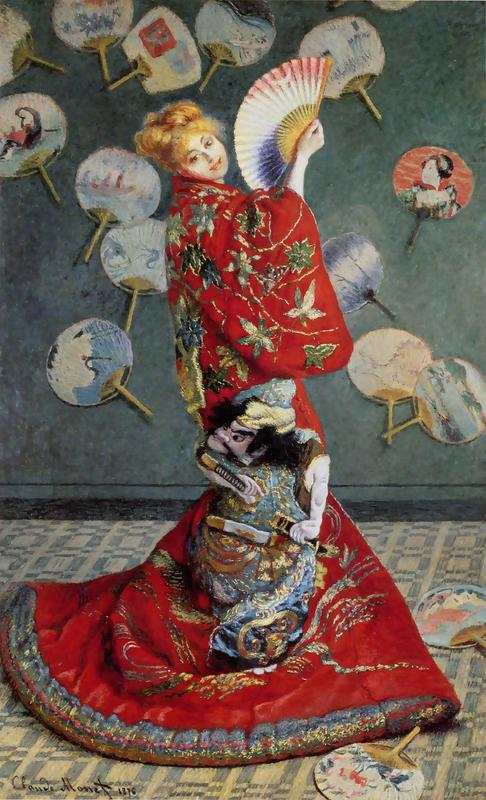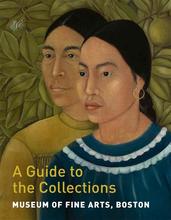More about Camille Monet in Japanese Costume
- All
- Info
- Shop

Sr. Contributor
Japonaise is French for “Japanese woman,” not to be confused with the very similar-sounding Japonisme, which is another French term that is kind of a catch-all referring to the popularity and influence of Japanese art, clothing, and goods that swept across France and elsewhere in Europe after Japan opened their country to trade with the West during the 1850s.
This moment in Japanese history began what is known as the Meiji Restoration, and it was not completely voluntary on the part of Japan; in very simple terms, the U.S Navy made them an offer they couldn’t refuse.
This painting, while an example of Japonisme, was also a subset of a larger art movement, known as Orientalism, in which Western artists painted their (usually romanticized) versions of a large swath of not only Asia, but the Middle East and North Africa, as well. La Japonaise, in the collection of the Museum of Fine Arts Boston, is obviously not a portrait of a Japanese woman; as the English title says, this is Claude Monet’s first wife, Camille, who often modeled for him (as would his second wife, Alice). When this work was painted, Japonisme was in full swing amongst many artists in Europe during the time, including Vincent van Gogh, James McNeill Whistler, and Edgar Degas, among others.
Today, the whole Japonisme thing could be seen as an example of cultural appropriation, mainly because it was based on the European, or Western, view of Japanese culture and art. In 2015, the Museum of Fine Arts Boston generated some negative publicity for a promotion they did with Monet’s painting called "Kimono Wednesdays." Someone there thought it would be a good idea to offer visitors the opportunity to dress up as the woman in this work, in order to provide a photo op. It also didn’t help that the program was titled Claude Monet: Flirting with the Exotic, "exotic" being an outdated word used to describe people from non-Western parts of the world.
The museum provided replicas of the kimono Camille wore in the painting for the visitors to wear, seemingly without any context, other than it was the same style kimono as that in the artwork. This program led to a number of negative statements online, ranging from “vilely racist” to “cultural appropriation at its finest.” There was also a group that staged protests in the gallery, voicing their displeasure at the “orientalism” that was on display, the main complaint being that there was not any educational material regarding the aforementioned “-isms,” the political dynamics between the U.S, Europe and Japan at the time, or the kimono itself.
Eventually, the museum realized that they weren’t going to come out of this one looking good, so they apologized and canceled the dress-up portion of the program (keeping the kimonos to see and touch), while adding more talks by museum educators to address the context of the painting. The museum also felt the need to mention that while the painting was on loan in Japan, replica kimonos were made available for visitors to try on without any public protest.
All contemporary controversy aside, the painting wasn’t exactly a smash hit when it was first shown at the second exhibition of the Expressionists in 1876. Some of the tougher critics said of the woman that she was like a "great doll, with nothing human about her face," a "demimondaine," and a "two-headed Chinese." Harsh! However, those critiques didn’t keep it from finding an eager buyer; it sold the same month as the exhibition.
Sources
- Boucher, Brian. “MFA Boston Cancels Kimono Event.” artnet News. artnet News, July 8, 2015. https://news.artnet.com/art-world/museum-of-fine-arts-boston-apologizes….
- Boucher, Brian. “Outrage at Boston Museum of Fine Arts.” artnet News, December 27, 2016. https://news.artnet.com/art-world/outrage-boston-museum-of-fine-arts-di….
- “Conservation in Action: La Japonaise.” Museum of Fine Arts, Boston. https://www.mfa.org/collections/conservation/conservation-in-action/la-….
- Cook, Greg. “MFA Director On Kimono Controversy: 'I Think That Was Misguided And Apologize'.” The ARTery. WBUR, February 8, 2016. https://www.wbur.org/artery/2016/02/08/mfa-kimono-controversy.
- Ives, Colta. “Japonisme.” metmuseum.org, October 2004. https://www.metmuseum.org/toah/hd/jpon/hd_jpon.htm.
- “Japonism Movement Overview.” The Art Story. https://www.theartstory.org/movement/japonism/
- Smith, Evan F. “Demonstrators Protest Cultural Appropriation in MFA Galleries.” Big Red & Shiny, July 7, 2015. http://bigredandshiny.org/18982/demonstrators-protest-cultural-appropri…
- Tate. “Japonisme – Art Term.” Tate.https://www.tate.org.uk/art/art-terms/j/japonisme.
- “The Meiji Restoration: The End of the Shogunate and the Building of a Modern Japanese State.” nippon.com, May 30, 2020. https://www.nippon.com/en/views/b06902/.
Featured Content
Here is what Wikipedia says about La Japonaise (painting)
La Japonaise is an 1876 oil painting by the French Impressionist painter Claude Monet. Painted on a
231.8 cm × 142.3 cm (91+1⁄4 in × 56 in) canvas, the full-length portrait depicts a European woman in a red uchikake kimono standing in front of a wall decorated by Japanese fans. Monet's first wife Camille Doncieux modeled for the painting.
The painting was first exhibited in the second Impressionism exhibition of 1876, and is now exhibited at the Museum of Fine Arts, Boston.
Check out the full Wikipedia article about La Japonaise (painting)













